25 April 2023: Database Analysis
Evolution of Inguinal Hernia Publications: A Bibliometric Analysis from 1980 to 2021
İbrahim Tayfun ŞahinerDOI: 10.12659/MSM.939613
Med Sci Monit 2023; 29:e939613
Abstract
BACKGROUND: Despite the increasing number of studies published worldwide focusing on inguinal hernia, a major condition in the surgical field that affects the quality of life of many patients, a bibliometric study on inguinal hernia is yet to be conducted. The present study aimed to analyze the scientific articles published on inguinal hernia using statistical methods.
MATERIAL AND METHODS: Articles published between 1980 and 2021 on inguinal hernia were downloaded from the Web of Science database and analyzed using statistical methods.
RESULTS: A total of 11 761 publications were found. The top 5 contributors to the literature were the United States (n=2109, 27%), Germany (563, 6.7%), United Kingdom (595, 5.7%), Turkey (415, 5.3%), and Japan (388, 4.9%). The top 3 most influential journals by average number of citations per article were Annals of Surgery (citations: 67.4), British Journal of Surgery (citations: 49.9), and Surgical Clinics of North America (citations: 43.2).
CONCLUSIONS: In the current comprehensive bibliometric study on inguinal hernia, which has demonstrated an upward trend in the number of articles published recently, we present a summary of 7810 articles published from 1980 to 2021. According to the results of the analysis conducted to identify trending topics, the keywords studied in recent years are believed to include pediatric, outcomes, minimally invasive surgery, robotic, incisional hernia, umbilical hernia, chronic pain, obesity, bariatric surgery, NSQIP, seroma, surgical site infection, abdominal wall reconstruction, ventral hernia repair, and hiatal hernia repair.
Keywords: Bibliometrics, Hernia, Femoral, Hernia, Inguinal, Laparoscopy, Humans, United States, Child, Quality of Life, Publications, North America
Background
Inguinal hernia is the protrusion of abdominal or preperitoneal fat content through a hernia defect in the groin area, which can be caused by congenital factors or stretching of the abdominal wall [1,2]. The main anamneses of inguinal hernia include symptoms such as groin swelling, pain, duration of complaints, reducibility, symptoms and findings of incarceration, and previous hernia surgeries [1]. Predisposing factors include smoking, abdominal aortic aneurysm, chronic obstructive pulmonary disease, prostatectomy, appendectomy, positive family history, long-term exposure to tasks involving heavy lifting, and peritoneal dialysis [1]. According to the latest findings, the risk factors identified for inguinal hernia were male sex, age, low body mass index, positive family history, history of hernia formation on the other side, abnormal collagen metabolism, and prostatectomy [2]. Inguinal hernia can be easily diagnosed using physical examination (sensitivity, 74.5–92%; specificity, 93%). Ultrasonography is a useful noninvasive technique that assists in physical examination. Herniorrhaphy is safe in cases of hidden hernia. Less commonly, magnetic resonance imaging or computed tomography scans can also be required [1–3].
There is no standard repair technique for all inguinal hernias. Many different techniques and approaches (non-mesh techniques: the Shouldice, Bassini, and Marcy techniques; and mesh techniques: the anterior open approach, posterior open approach, and posterior endoscopic approach) are used in treating inguinal hernias, and these techniques and approaches vary for different cultures, understandings, and economic reasons [1,2]. While deciding the treatment to be administered, factors such as recurrence risk, risk of complications, postoperative recovery and quality of life, degree of difficulty, and hospital-related and social costs are considered [4]. The guidelines recommend watchful waiting for men with asymptomatic or minimally symptomatic inguinal hernias because they are at a low risk. Surgical treatment for symptomatic inguinal hernias and urgent surgery for strangulated inguinal hernias are recommended [1,2]. However, the policy of operating on all cases of inguinal hernia in older adults can result in higher rates of morbidity and mortality [1,2].
Among the common topics of discussion at all times are the indications for inguinal hernia treatment, whether or not to administer surgical treatment, and deciding the best technique to be used to treat hernias by considering multiple factors, such as postoperative recovery time, postoperative pain, relapse, complications, economic costs, whether the open-laparoscopic approach or the mesh/non-mesh approach is more appropriate, most appropriate anesthesia approach, and whether routine antibiotic use is essential [1,5–10]. However, a definitive indicator of the best surgical option for treating inguinal hernia has yet to be identified. According to a recent meta-analysis study involving 35 randomized controlled trials published from 1996 to 2019, compared with the Lichtenstein tension-free repair, the minimally invasive repair techniques of transabdominal preperitoneal (TAPP) repair and totally extraperitoneal (TEP) repair were found to yield similar outcomes in terms of hernia relapse, seroma, and hospital stay, whereas TAPP and TEP had significantly reduced early postoperative pain, time until return to work, chronic pain, hematoma, and wound infection [11].
Although the incidence and prevalence of inguinal hernia is not fully known, men are relatively likely (27%) to undergo inguinal hernia surgery in their lifetime, whereas this rate is lower in women (3%) [1,12]. More than 20 million patients worldwide undergo inguinal hernia repairs every year [2,11].
Bibliometrics is the analysis of many scientific publications using various statistical methods [13–17]. In parallel with the increasing number of studies published in the literature, particularly over the recent years, bibliometric studies have been conducted involving studies available in numerous medical fields [13–17]. Thanks to bibliometric investigations, influential studies and journals, most active authors, institutions, and countries that are most cited on a subject from the past to the present can be identified [13,14]. Researchers can also master the literature more quickly by reading summaries of the available findings that bibliometric studies obtain by means of analyzing thousands and sometimes tens of thousands of articles. Thanks to the current trends presented in such studies, the studies can also help researchers come up with ideas for further studies [14].
Despite the increasing number of studies published worldwide focusing on inguinal hernia, which is considered a major condition in the surgical field, there are no bibliometric studies on this condition. The present study therefore aimed to analyze scientific articles published on inguinal hernia from 1980 to 2021 using various statistical and bibliometric methods. The analyses herein were performed to identify the most influential studies and journals and the most active authors, institutions, and countries, as well as to determine international collaborations between countries, global productivity, and trending topics.
Material and Methods
STATISTICAL ANALYSIS:
Statistical analyses were performed with SPSS (version 22.0, IBM Corp, Armonk, NY, USA). The normal distribution test of the data was performed with the Kolmogorov-Smirnov test. In order to evaluate the relationship between the world’s publication productivity on inguinal hernia and the economic power of the countries, the correlations between the number of articles published by their countries and some economic development indicators of the countries (gross domestic product [GDP] and GDP per capita) were analyzed with the Spearman correlation coefficient since the data were not normally distributed (data obtained from the World Bank [18]). The Spearman correlation coefficient was used for the relationship between the number of articles published by countries and GDP values (used to determine the relationship between numerical data). A value of P<0.05 indicated a statistically significant correlation.
The Exponential Smoothing estimator was used in Microsoft Office Excel to estimate the number of publications in the coming years based on past publication trends. The Excel package program presents the model results of this estimator (for detailed information: ‛https://www.excel-easy.com/examples/exponential-smoothing.html;)”. The website (https://app.datawrapper.de) was used for world map drawing. The VOSviewer (version 1.6.16, Leiden University’s Center for Science and Technology Studies) package program was used for bibliometric network visualizations and citation analysis [19]. In citation analysis and trend keyword analysis, the theoretical framework is not presented. These analyses were carried out directly in the VOSviewer program.
Results
DEVELOPMENT OF PUBLICATIONS BY YEAR:
The distribution of the number of published articles by year is shown in Figure 1. The estimation values of the results of the Exponential Smoothing estimation model, which is used to predict the number of articles that can be published in 2022 and beyond, are shown in Figure 1. According to the estimation model results, it is estimated that 566 (95%CI: 465–668) articles will be published in 2022 and 616 (95%CI: 407–826) articles will be published in 2026 on inguinal hernia (Figure 1).
ACTIVE COUNTRIES:
The distribution of the number of articles by country is shown in Figure 2. The first 25 countries with the highest number of articles published were the United States (2109, 27%), Germany (563, 6.7%), United Kingdom (595, 5.7%), Turkey (415, 5.3%), Japan (388, 4.9%), China (383, 4.9%), India (379, 4.8%), Italy (341, 4.3%), France (267, 3.4%), Netherlands (249, 3.1%), Spain (197, 2.5%), Sweden (195, 2.4%), Denmark (193, 2.4%), Canada (163, 2%), Australia (159, 2%), Switzerland (129, 1.6%), Belgium (122, 1.5%), South Korea (117, 1.4%), Austria (115, 1.4%), Egypt (102, 1.3%), Pakistan (101, 1.2%), Taiwan (95, 1.2%), Greece (91, 1.1%), Brazil (84, 1%), and Poland (77, 0.9%).
Cluster analysis was performed among the 49 countries that produced at least 10 articles from 127 countries that published articles on inguinal hernia and whose authors have international cooperation, as shown in Figure 3A. According to the results of the cluster analysis, 8 different clusters related to international cooperation were formed (cluster 1: Austria, Belgium, Croatia, Czech Republic, Denmark, Germany, Italy, Netherlands, Poland, Portugal; cluster 2: Egypt, India, Pakistan, China, Saudi Arabia, Singapore, South Korea, Taiwan, Thailand; cluster 3: Finland, Greece, Iran, Ireland, Romania, Russia, Serbia, Turkey; cluster 4: Argentina, Canada, Chile, Japan, Mexico, United States; cluster 5: Australia, England, New Zealand, Scotland, South Africa, Wales; cluster 6: Brazil, France, Israel, Spain; cluster 7: Ghana, Norway, Sweden; and cluster 8: Nepal, Nigeria, Switzerland). In addition, total link strength scores showing the cooperation power of 50 countries were calculated, and the international collaboration density map created according to these scores is shown in Figure 3B (the top 15 countries with the highest score: United States=257, Germany=215, England [in UK]=184, Italy=135, Netherlands=114, Sweden=113, Belgium=110, Denmark=106, France=106, Spain=99, Austria=92, Switzerland=91, Scotland=82, Canada=74, Australia=41).
CORRELATION ANALYSIS:
A statistically significant positive correlation was found between the number of articles produced by countries on inguinal hernia and GDP values (r=0.722,
ACTIVE AUTHORS:
The top 10 most active authors on inguinal hernia were Rosenberg J (n=83), Heniford BT (62), Rosen MJ (61), Kockerling F (58), Bittner R (56), Schumpelick V (54), Roth JS (49), Bisgaard T (46), Nordin P (46), and Kehlet H (38).
ACTIVE INSTITUTIONS:
The top 20 most active institutions that published the most articles on inguinal hernia were the University of Copenhagen (n=165), United States Department of Veterans Affairs (92), University of California System (91), University of Texas System (91), Cleveland Clinic Foundation (90), Veterans Health Administration (USA) (90), Egyptian Knowledge Bank (85), Humboldt University of Berlin (83), Free University of Berlin (81), Charite Universitatsmedizin Berlin (80), Assistance Publique Hopitaux Paris APHP (75), Harvard University (74), Carolinas Medical Center (73), Karolinska Institutet (72), RWTH Aachen University (72), Erasmus University Rotterdam (66), Mayo Clinic (66), Vanderbilt University (63), Erasmus MC (60), Johns Hopkins University (58), and Lund University (58).
ACTIVE JOURNALS:
A total of 7810 articles on inguinal hernia were published in 967 different journals. The first 48 most active journals that published 30 or more articles from these journals, total number of citations received by the journals, and average number of citations per article are presented in Table 1. The citation network visualization map between these journals is presented in Figure 4.
CITATION ANALYSIS:
Among the 7810 articles published on inguinal hernia, the first 25 articles with the highest number of citations according to the total number of citations are presented in Table 2. In the last column of Table 2, the average number of citations the articles received per year is given.
CO-CITATION ANALYSIS:
A total of 53 685 studies were cited in the references section of all 7810 articles published on inguinal hernia. Among these studies, the 8 studies with the most co-citations (more than 250 citations) were Simons et al (2009; number of citations [NC]=492), Lichtenstein et al (1989; NC=451), Luijendijk et al (2000; NC=348), Neumayer et al (2004; NC=345), Simons et al (2018; NC=331), Burger et al (2004; NC=301), Mccormack et al (2003; NC=287), and Heniford et al (2003; NC=251) [1,2,5–7,8–10].
TREND TOPICS:
In all the 7810 articles published on inguinal hernia, 7438 different keywords were used. Among these keywords, 83 different keywords that were used in at least 30 different articles are shown in Table 3. The cluster network visualization map showing the results of cluster analysis performed between these keywords is shown in Figure 5. The trend network visualization map performed to identify trend topics is shown in Figure 6, and the citation network visualization map performed to reveal the most cited topics is shown in Figure 7.
Discussion
When the articles on inguinal hernia published from 1980 to 2021 were examined for distribution by year, 25 to 77 (average: 48) articles were published during the period 1980 to 1995. Between the years 1996 and 2007, 101 to 180 (average: 124) articles were published. Between the years 2008 and 2021, 226 to 650 (average: 397) articles were published. There was a remarkable upward trend that started in 2007–2008 and continued until 2020 when the number reached 650 articles. The results from the forecasts of the next 5 years indicate that the number of articles will continue demonstrating an upward trend.
When the studies were examined for distribution by country of publication, 19 of the top 25 most active countries that contributed the most to article productivity on inguinal hernia were developed countries: United States, Germany, United Kingdom, Japan, Italy, France, Netherlands, Spain, Sweden, Denmark, Canada, Australia, Switzerland, Belgium, South Korea, Austria, Taiwan, Greece, and Poland. Only 6 of the 25 active countries were developing countries with large economies: Turkey, China, India, Egypt, Pakistan, and Brazil. According to the correlation analysis, there was a high and significant correlation between article productivity and GDP and a moderate and significant correlation between article productivity and GDP per capita. Accordingly, when we evaluate the active countries together, we believe the economic size and level of development of the countries primarily affect the article productivity of the literature on inguinal hernia. We attribute the ranking of India, Egypt, and Pakistan among the 25 most active countries to the high rates of prevalence of inguinal hernia in these countries.
Although tension-free mesh repair of inguinal hernia is a standard technique in many developed countries, mesh is used to a lesser extent in developing countries because of its initial cost [20]. Therefore, studies were conducted to assess the effectiveness and safety of low-cost mesh use [21]. The small volume of contribution from developing or undeveloped countries in article productivity may be because of the inadequate number of cases operated using high-cost techniques and consequently the inability to conduct randomized controlled trials, as well as the inadequate amount of funds allocated for research. Therefore, we believe that support should be provided for studies on inguinal hernia to be conducted in economically less developed countries.
According to the density map created in reference to the total international collaboration scores of each country, the United States, Germany, England (in UK), Italy, Netherlands, Sweden, Belgium, Denmark, France, Spain, Austria, Switzerland, Scotland, Canada, and Australia were the countries with the highest level of engagement in collaborations with other countries. When the co-authorship collaboration of countries on inguinal hernia was examined, despite the presence of some collaborations between countries that are not geographical neighbors of each other (United States-Japan; Brazil-Israel), the collaborations between geographically neighboring countries (Germany-Belgium-Poland-Netherlands-Austria-Italy-Czech Republic; Taiwan-South Korea-China-India; Australia-New Zealand; United States-Canada-Mexico; Argentina-Chile; Turkey-Greece-Romania; and Norway-Sweden) were found to be more effective in producing articles.
The journals that published the most articles on inguinal hernia were Hernia, Surgical Endoscopy and Other Interventional Techniques, American Surgeon, Journal of Pediatric Surgery, Journal of Laparoendoscopic & Advanced Surgical Techniques, American Journal of Surgery, British Journal of Surgery, World Journal of Surgery, Surgical Laparoscopy Endoscopy & Percutaneous Techniques, International Journal of Surgery Case Reports, Chirurg, and Journal of the American College of Surgeons, respectively. We can recommend that authors who are in the research process of inguinal hernia and want to publish, first consider these journals. When the citation analyses of the journals were evaluated, the most effective journals were determined as Annals of Surgery, British Journal of Surgery, Surgical Clinics of North America, Archives of Surgery, Surgical Endoscopy-Ultrasound and Interventional Techniques, Journal of the American College of Surgeons, European Journal of Surgery, Surgery, Surgical Laparoscopy & Endoscopy, World Journal of Surgery, and American Journal of Surgery, respectively, according to the average number of citations they received per article they published. For those researchers who want their work to be published and cited more, we can recommend these journals first.
When the analyzed articles were evaluated according to the total number of citations they received, the study “Open mesh versus Laparoscopic mesh repair of inguinal hernia” by Neumayer et al (2004), which was published in the New England Journal of Medicine, was found to have the highest number of citations [7]. The second most influential study was an article titled “International guidelines for groin hernia management” published in Hernia by Simons et al (The HerniaSurge Group; 2018) [2]. The third most influential study was an article titled “Epidemiology and cost of ventral hernia repair: making the case for hernia research” by Poulose et al (2012), which was published in Hernia [22]. The fourth most influential study was an article titled “Demographic and socioeconomic aspects of hernia repair in the United States in 2003” by Rutkow (2003), which was published in Surgical Clinics of North America [23]. The fifth most influential study was an article titled “Comparison of conventional anterior surgery and laparoscopic surgery for inguinal-hernia repair” by Liem (1997), which was published in the New England Journal of Medicine [24]. According to the evaluation of the articles by average number of citations per year, the most influential study was the study by Simons et al (2018; The HerniaSurge Group), whereas the second and third most influential studies were those by Poulose et al (2012) and Neumayer et al (2004), respectively [2,22,7]. The fourth most influential study was an article titled “The analgesic efficacy of pre-operative bilateral erector spinae plane (ESP) blocks in patients having ventral hernia repair” by Chin (2017), which was published in Anesthesia [25]. The fifth most influential study was an article titled “Guidelines for laparoscopic (TAPP) and endoscopic (TEP) treatment of inguinal Hernia [International Endohernia Society (IEHS)]” by Bittner (2011), which was published in Surgical Endoscopy and Other Interventional Techniques [26]. According to the co-citation numbers of all the analyzed articles, studies by Simons et al (2009), Lichtenstein et al (1989), Luijendijk et al (2000), Neumayer et al (2004), Simons et al (2018), Burger et al (2004), Mccormack et al (2003), and Heniford et al (2003) were found to be the most influential studies [1,2,5–7,8–10]. We recommend that clinicians and researchers interested in this topic peruse these studies first.
According to the findings from the keyword-based analysis, cluster analysis showed that the topics of inguinal hernia were studied in clusters of 6 different colors (the clusters were pain/analgesia, methods, recurrence, and ventral hernia). The most cited keywords were polypropylene, incisional hernia, biologic mesh, abdominal wall reconstruction, ventral, laparoscopic herniorrhaphy, laparoscopic ventral hernia repair, learning curve, mesh fixation, and analgesia. According to the results of the analysis conducted to identify trending topics, the keywords studied in recent years included pediatric, outcomes, minimally invasive surgery, robotic, incisional hernia, umbilical hernia, chronic pain, obesity, bariatric surgery, NSQIP, seroma, surgical site infection, abdominal wall reconstruction, ventral hernia repair, and hiatal hernia repair. We can explain the relationship between the number of publications and past and future trend keywords as follows. First, during the analysis, we identified 7438 different keywords used in 7810 articles. However, from these keywords, we chose keywords that have been used in at least 30 different studies. For example, if a keyword was used in 25 different articles, we excluded it, because in order for a keyword to be a trend, it must first be used in different studies many times. In this way, we identified 83 different keywords used in 30 or more studies and analyzed them with the VOSviewer program and separated them according to their years of use and revealed which years they were used more with different colors. Thus, past and future trends were determined.
In our literature review on inguinal hernia, we did not encounter any bibliometric studies. The fact that this comprehensive study on this topic is the first bibliometric research can be considered as one of the strengths of the present study. A limitation of the present study is that we only used the WoS database in the literature review. Another limitation of this study is that of meta-analyses; since keywords such as mesh and herniorrhaphy are frequently used, a few articles containing hiatal and incisional hernias have been included in the database, albeit limitedly. However, citation and co-citation analyses cannot be performed in the PubMed database. In the Scopus database, journals with low impact levels are also indexed [13,14]. In recent years, the WoS database has been widely preferred in bibliometric analyses [13–17]. The WoS database indexes articles published in journals that are more influential than other databases [13–15]. You can use the https://www.vosviewer.com/features/examples link for details about this topic.
Conclusions
In the present comprehensive bibliometric study focusing on inguinal hernia, which has demonstrated an upward trend in the number of articles published recently, we present a summary of 7810 articles published between 1980 and 2021. We conclude that the number of articles on inguinal hernia will continue to demonstrate an upward trend. According to our global productivity findings, we are of the opinion that, in economically less developed countries, more support should be provided for studies to be conducted on inguinal hernia. According to the results of the analysis conducted to identify trending topics, the keywords studied in recent years include pediatric, outcomes, minimally invasive surgery, robotic, incisional hernia, umbilical hernia, chronic pain, obesity, bariatric surgery, NSQIP, seroma, surgical site infection, abdominal wall reconstruction, ventral hernia repair, and hiatal hernia repair. This study can be a useful resource for clinicians, scientists, and surgical assistants, thanks to the data it can make available regarding the global outputs on inguinal hernia.
Figures
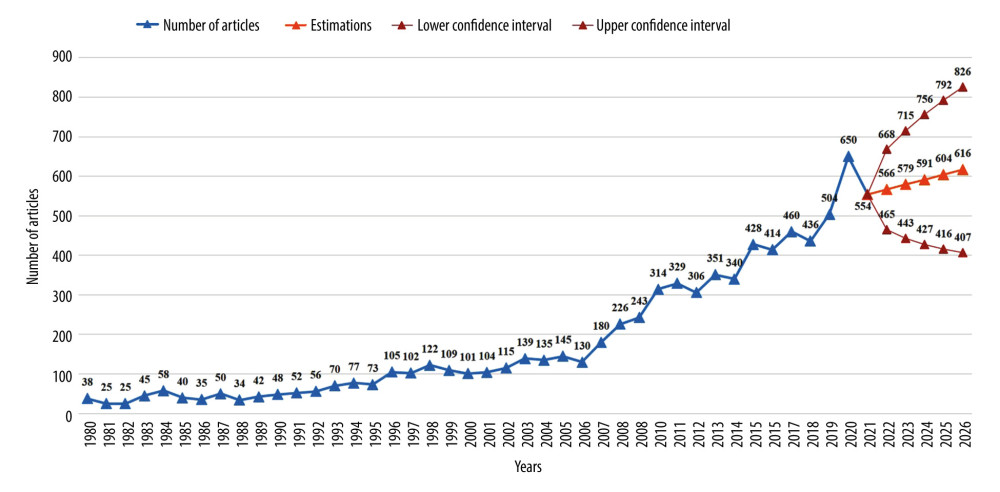 Figure 1. Distribution of articles published on inguinal hernia by year and estimates of the number of articles for the next 5 years. Created by Microsoft Office Excel (Office 365) package program (licensed to Hitit University, 2022).
Figure 1. Distribution of articles published on inguinal hernia by year and estimates of the number of articles for the next 5 years. Created by Microsoft Office Excel (Office 365) package program (licensed to Hitit University, 2022). 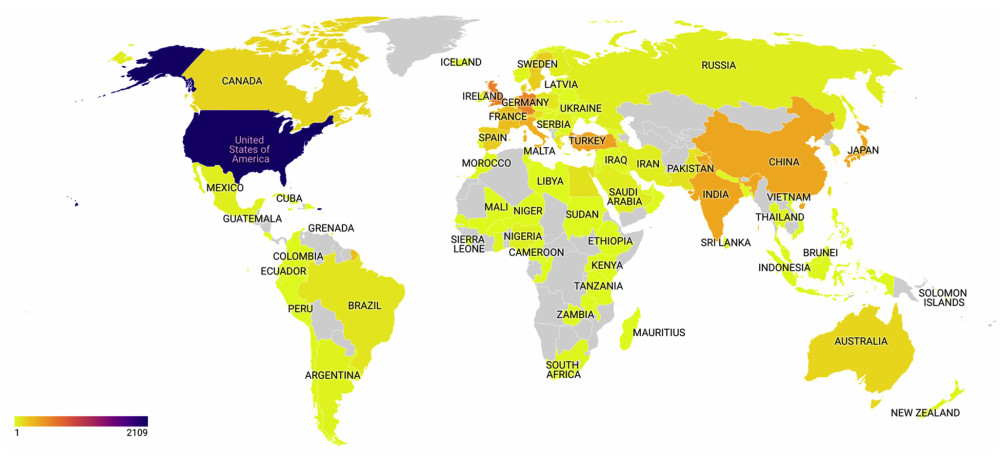 Figure 2. Global productivity world maps showing the distribution of published articles on inguinal hernia by country. Created by open-source world map on the https://app.datawrapper.de.
Figure 2. Global productivity world maps showing the distribution of published articles on inguinal hernia by country. Created by open-source world map on the https://app.datawrapper.de. 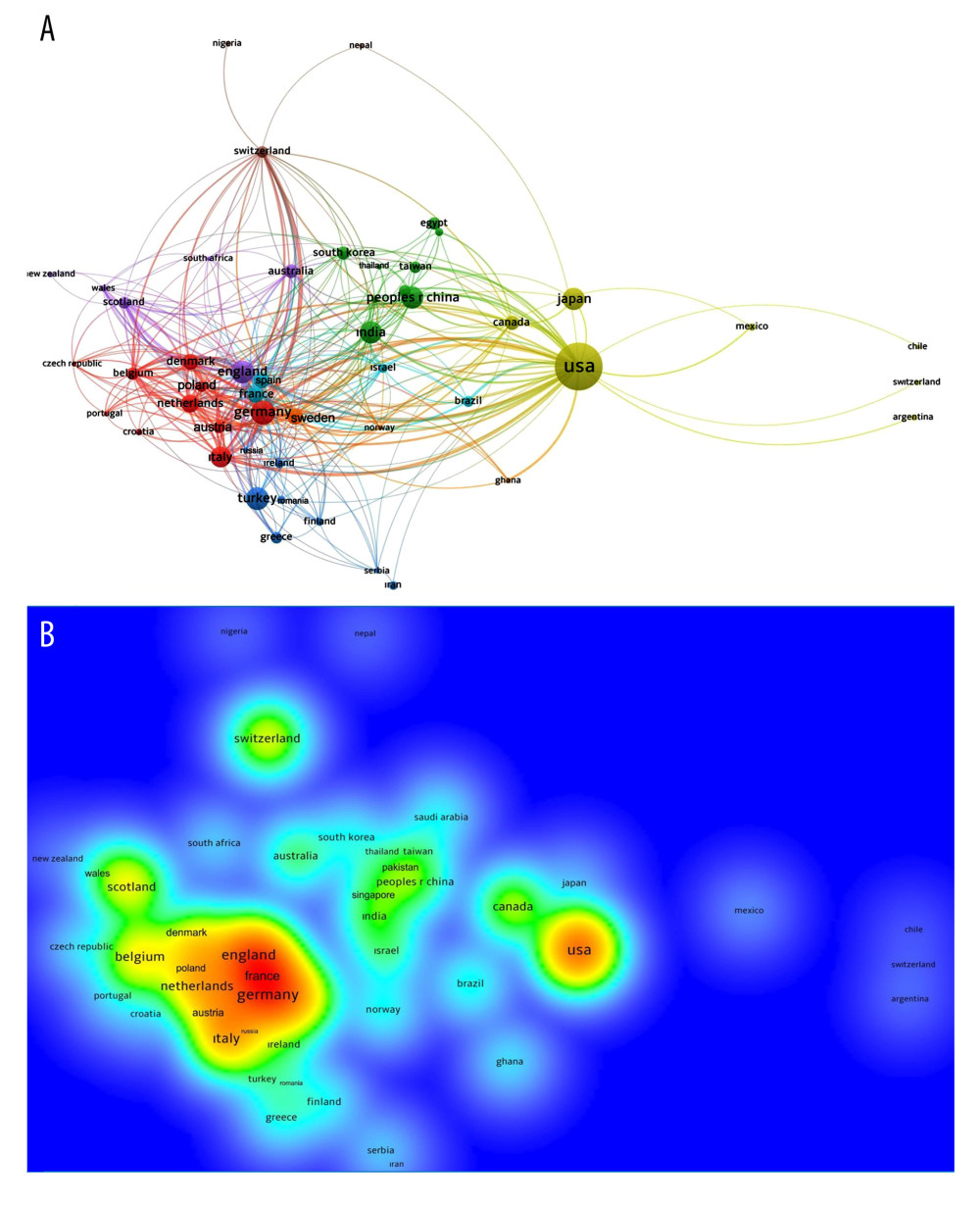 Figure 3. (A) Network visualization map of cluster analysis showing cooperation between countries on inguinal hernia. Colors indicate clustering. The size of the circle indicates the large number of articles. The larger the size of the circle, the more articles the country publishes. Created by VOSviewer (version 1.6.16, Leiden University’s Center for Science and Technology Studies). (B) Density map showing the intensity of international cooperation of countries on inguinal hernia. The strength of international collaboration score increases from blue to red (blue-green-yellow-red). Created by VOSviewer (version 1.6.16, Leiden University’s Center for Science and Technology Studies).
Figure 3. (A) Network visualization map of cluster analysis showing cooperation between countries on inguinal hernia. Colors indicate clustering. The size of the circle indicates the large number of articles. The larger the size of the circle, the more articles the country publishes. Created by VOSviewer (version 1.6.16, Leiden University’s Center for Science and Technology Studies). (B) Density map showing the intensity of international cooperation of countries on inguinal hernia. The strength of international collaboration score increases from blue to red (blue-green-yellow-red). Created by VOSviewer (version 1.6.16, Leiden University’s Center for Science and Technology Studies). 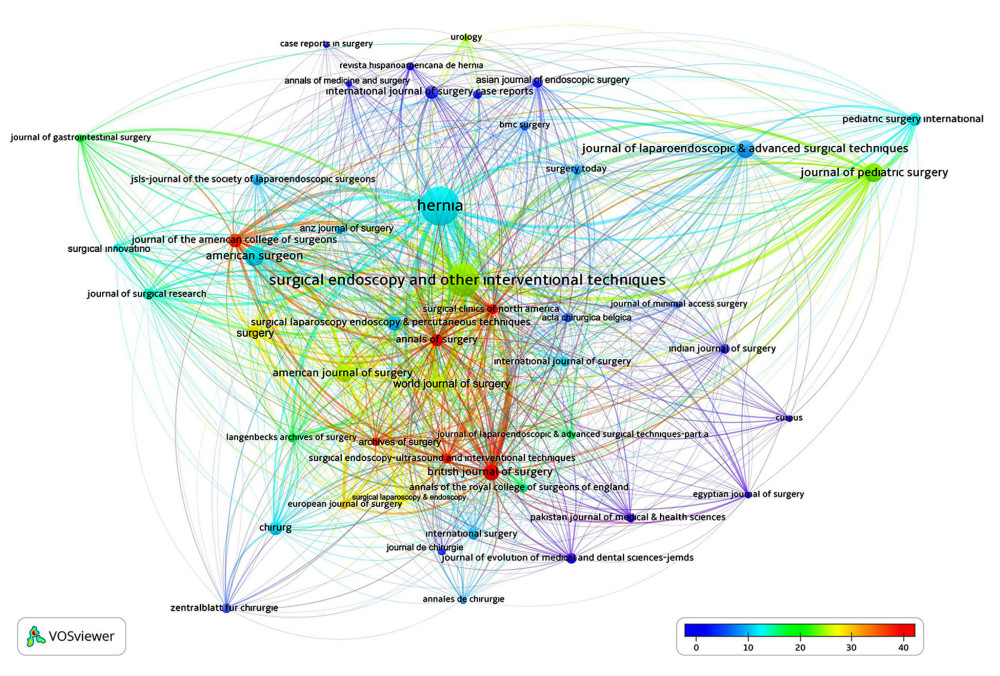 Figure 4. Network visualization map for analysis of citations per article of active journals that publish the most articles on inguinal hernia. The size of the circle indicates the large number of articles. The average number of citations per article by journals increases from blue to red (blue-green-yellow-red). Created by VOSviewer (version 1.6.16, Leiden University’s Center for Science and Technology Studies).
Figure 4. Network visualization map for analysis of citations per article of active journals that publish the most articles on inguinal hernia. The size of the circle indicates the large number of articles. The average number of citations per article by journals increases from blue to red (blue-green-yellow-red). Created by VOSviewer (version 1.6.16, Leiden University’s Center for Science and Technology Studies). 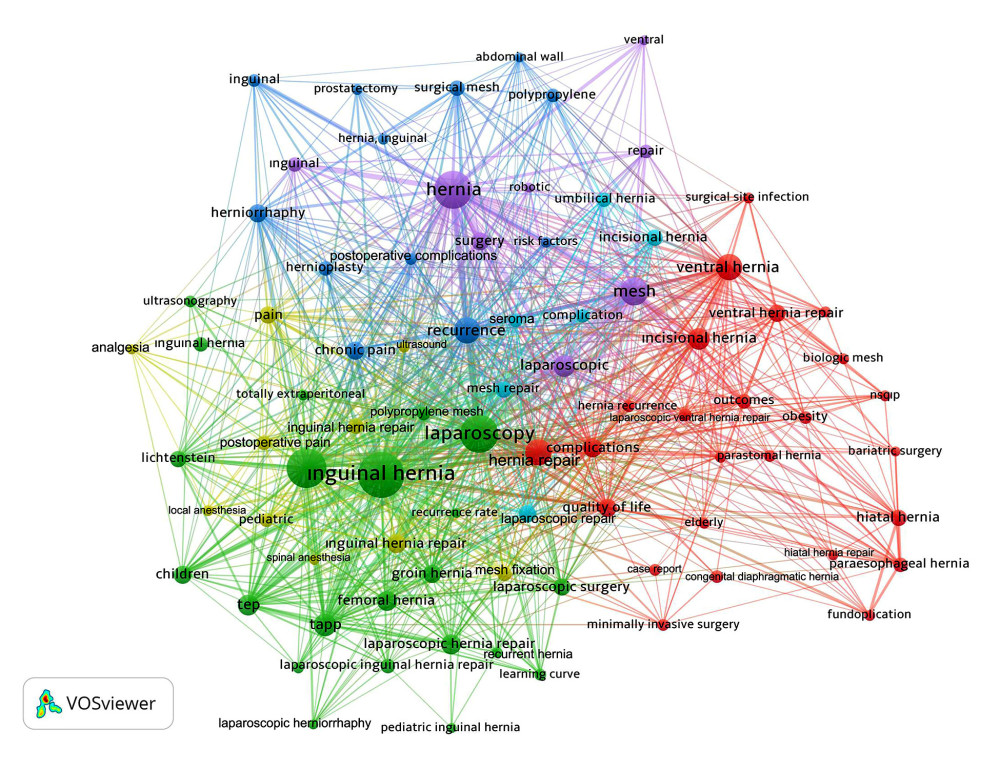 Figure 5. Network visualization map for cluster analysis based on keyword analysis performed to identify clustering of inguinal hernia subjects. Colors indicate clustering. Keywords in the same cluster are of the same color. The size of the circle indicates the number of uses of the keyword. Created by VOSviewer (Version 1.6.16, Leiden University’s Center for Science and Technology Studies).
Figure 5. Network visualization map for cluster analysis based on keyword analysis performed to identify clustering of inguinal hernia subjects. Colors indicate clustering. Keywords in the same cluster are of the same color. The size of the circle indicates the number of uses of the keyword. Created by VOSviewer (Version 1.6.16, Leiden University’s Center for Science and Technology Studies). 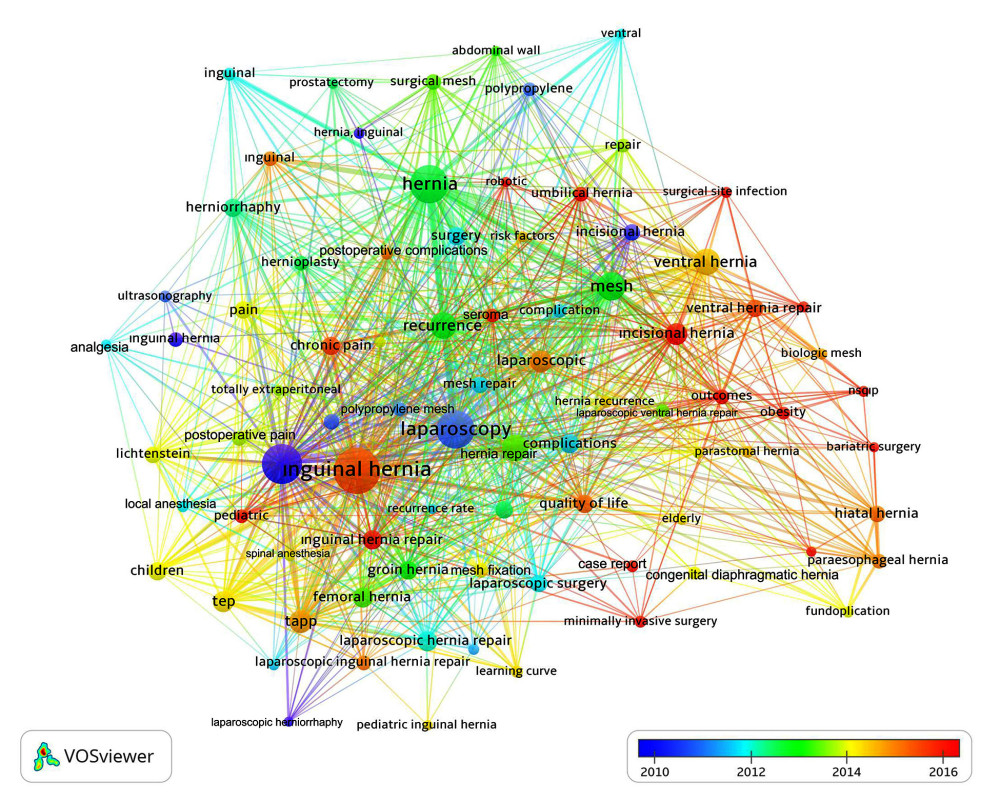 Figure 6. Network visualization map based on keyword analysis to identify past and current trends in inguinal hernia. In the indicator given in the lower right corner of the figure, the topicality of the article increases from blue to red (blue-green-yellow-red). The size of the circle indicates the number of uses of the keyword. Created by VOSviewer (Version 1.6.16, Leiden University’s Center for Science and Technology Studies).
Figure 6. Network visualization map based on keyword analysis to identify past and current trends in inguinal hernia. In the indicator given in the lower right corner of the figure, the topicality of the article increases from blue to red (blue-green-yellow-red). The size of the circle indicates the number of uses of the keyword. Created by VOSviewer (Version 1.6.16, Leiden University’s Center for Science and Technology Studies). 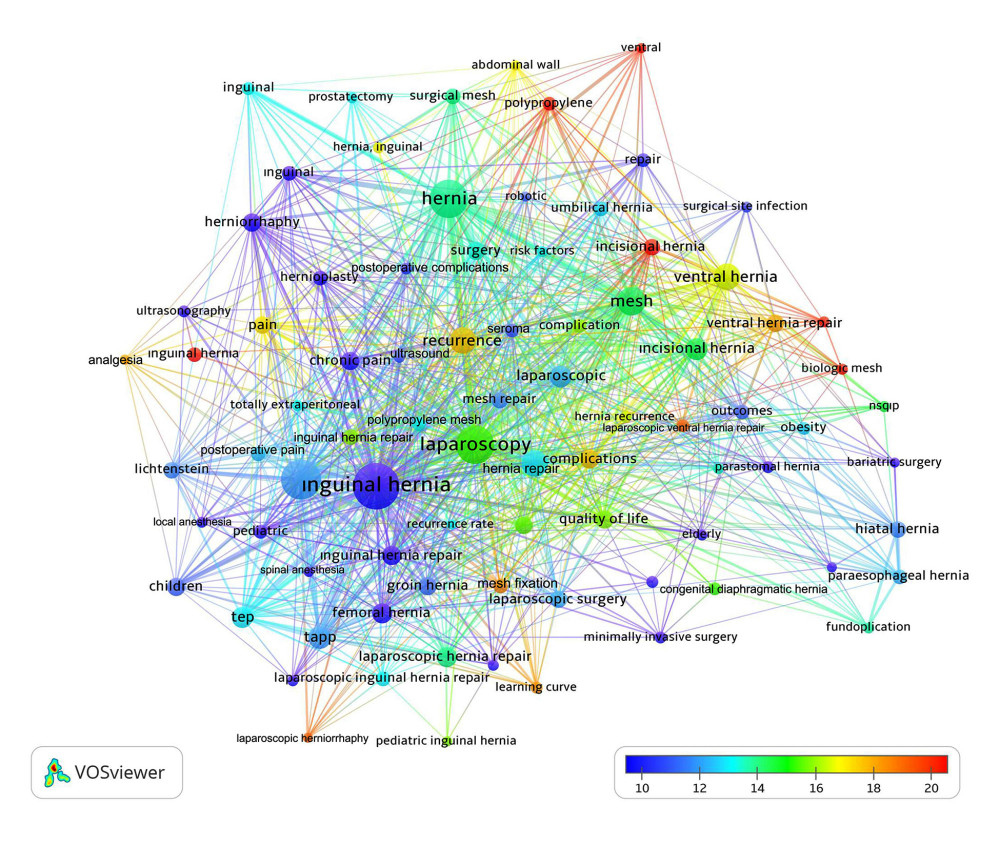 Figure 7. Network visualization map based on keyword analysis performed to identify the most cited topics in inguinal hernia. In the indicator given in the lower right corner of the figure, the number of citations received by the topic increases from blue to red Created by VOSviewer (version 1.6.16, Leiden University’s Center for Science and Technology Studies) (blue-green-yellow-red). The size of the circle indicates the number of uses of the keyword.
Figure 7. Network visualization map based on keyword analysis performed to identify the most cited topics in inguinal hernia. In the indicator given in the lower right corner of the figure, the number of citations received by the topic increases from blue to red Created by VOSviewer (version 1.6.16, Leiden University’s Center for Science and Technology Studies) (blue-green-yellow-red). The size of the circle indicates the number of uses of the keyword. References
1. Simons MP, Aufenacker T, Bay-Nielsen M, European Hernia Society guidelines on the treatment of inguinal hernia in adult patients: Hernia, 2009; 13(4); 343-403
2. HerniaSurge Group, International guidelines for groin hernia management: Hernia, 2018; 22(1); 1-165
3. Kraft BM, Kolb H, Kuckuk B, Diagnosis and classification of inguinal hernias: Surg Endosc, 2003; 17(12); 2021-24
4. Gallegos NC, Dawson J, Jarvis M, Hobsley M, Risk of strangulation in groin hernias: Br J Surg, 1991; 78(10); 1171-73
5. Lichtenstein IL, Shulman AG, Amid PK, Montllor MM, The tension-free hernioplasty: Am J Surg, 1989; 157(2); 188-93
6. Luijendijk RW, Hop WC, van den Tol MP, A comparison of suture repair with mesh repair for incisional hernia: N Engl J Med, 2000; 343(6); 392-98
7. Neumayer L, Giobbie-Hurder A, Jonasson OVeterans Affairs Cooperative Studies Program 456 Investigators, Open mesh versus laparoscopic mesh repair of inguinal hernia: N Engl J Med, 2004; 350(18); 1819-27
8. Burger JW, Luijendijk RW, Hop WC, Long-term follow-up of a randomized controlled trial of suture versus mesh repair of incisional hernia: Ann Surg, 2004; 240(4); 578-83 discussion 583–85
9. McCormack K, Scott NW, Go PMEU Hernia Trialists Collaboration, Laparoscopic techniques versus open techniques for inguinal hernia repair: Cochrane Database Syst Rev, 2003; 2003(1); CD001785
10. Heniford BT, Park A, Ramshaw BJ, Voeller G, Laparoscopic repair of ventral hernias: nine years’ experience with 850 consecutive hernias: Ann Surg, 2003; 238(3); 391-99 discussion 399–400
11. Aiolfi A, Cavalli M, Ferraro SD, Treatment of inguinal hernia: Systematic review and updated network meta-analysis of randomized controlled trials: Ann Surg, 2021; 274(6); 954-61
12. Primatesta P, Goldacre MJ, Inguinal hernia repair: Incidence of elective and emergency surgery, readmission and mortality: Int J Epidemiol, 1996; 25(4); 835-39
13. Demir E, Akmeşe ÖF, Erbay H, Bibliometric analysis of publications on house dust mites during 1980–2018: Allergol Immunopathol (Madr), 2020; 48(4); 374-83
14. Kiraz S, Demir E, Global scientific outputs of schizophrenia publications from 1975 to 2020: A bibliometric analysis: Psychiatr Q, 2021; 92(4); 1725-44
15. Golpinar M, Demir E, Global research output of the cerebellum: Yesterday, today, and tomorrow: J Anat Soc India, 2020; 69; 155
16. Yildirim E, Demir E, Comparative bibliometric analysis of fertility preservation: Ann Med Res, 2019; 26; 1622-28
17. Muslu Ü, Demir E, Development of rhinoplasty: Yesterday and today: Med Sci, 2019; 23; 294-301
18. The World Bank: GDP Current US$, 2021 Available from: https://data.worldbank.org/indicator/NY.GDP.MKTP.CD
19. van Eck NJ, Waltman L, Software survey: VOSviewer, a computer program for bibliometric mapping: Scientometrics, 2010; 84(2); 523-38
20. Ahmad MH, Pathak S, Clement KD, Aly EH, Meta-analysis of the use of sterilized mosquito net mesh for inguinal hernia repair in less economically developed countries: BJS Open, 2019; 3(4); 429-35
21. Pérez Lara FJ, Del Rey Moreno A, Oliva Muñoz H, Do we really know the symptoms of inguinal hernia?: Hernia, 2015; 19(5); 703-12
22. Poulose BK, Shelton J, Phillips S, Epidemiology and cost of ventral hernia repair: Making the case for hernia research: Hernia, 2012; 16(2); 179-83
23. Rutkow IM, Demographic and socioeconomic aspects of hernia repair in the United States in 2003: Surg Clin North Am, 2003; 83(5); 1045-51
24. Liem MS, van der Graaf Y, van Steensel CJ, Comparison of conventional anterior surgery and laparoscopic surgery for inguinal-hernia repair: N Engl J Med, 1997; 336(22); 1541-47
25. Chin KJ, Adhikary S, Sarwani N, Forero M, The analgesic efficacy of pre-operative bilateral erector spinae plane (ESP) blocks in patients having ventral hernia repair: Anaesthesia, 2017; 72(4); 452-60
26. Bittner R, Arregui ME, Bisgaard T, Guidelines for laparoscopic (TAPP) and endoscopic (TEP) treatment of inguinal hernia [International Endohernia Society (IEHS)]: Surg Endosc, 2011; 25(9); 2773-843
Figures
 Figure 1. Distribution of articles published on inguinal hernia by year and estimates of the number of articles for the next 5 years. Created by Microsoft Office Excel (Office 365) package program (licensed to Hitit University, 2022).
Figure 1. Distribution of articles published on inguinal hernia by year and estimates of the number of articles for the next 5 years. Created by Microsoft Office Excel (Office 365) package program (licensed to Hitit University, 2022). Figure 2. Global productivity world maps showing the distribution of published articles on inguinal hernia by country. Created by open-source world map on the https://app.datawrapper.de.
Figure 2. Global productivity world maps showing the distribution of published articles on inguinal hernia by country. Created by open-source world map on the https://app.datawrapper.de. Figure 3. (A) Network visualization map of cluster analysis showing cooperation between countries on inguinal hernia. Colors indicate clustering. The size of the circle indicates the large number of articles. The larger the size of the circle, the more articles the country publishes. Created by VOSviewer (version 1.6.16, Leiden University’s Center for Science and Technology Studies). (B) Density map showing the intensity of international cooperation of countries on inguinal hernia. The strength of international collaboration score increases from blue to red (blue-green-yellow-red). Created by VOSviewer (version 1.6.16, Leiden University’s Center for Science and Technology Studies).
Figure 3. (A) Network visualization map of cluster analysis showing cooperation between countries on inguinal hernia. Colors indicate clustering. The size of the circle indicates the large number of articles. The larger the size of the circle, the more articles the country publishes. Created by VOSviewer (version 1.6.16, Leiden University’s Center for Science and Technology Studies). (B) Density map showing the intensity of international cooperation of countries on inguinal hernia. The strength of international collaboration score increases from blue to red (blue-green-yellow-red). Created by VOSviewer (version 1.6.16, Leiden University’s Center for Science and Technology Studies). Figure 4. Network visualization map for analysis of citations per article of active journals that publish the most articles on inguinal hernia. The size of the circle indicates the large number of articles. The average number of citations per article by journals increases from blue to red (blue-green-yellow-red). Created by VOSviewer (version 1.6.16, Leiden University’s Center for Science and Technology Studies).
Figure 4. Network visualization map for analysis of citations per article of active journals that publish the most articles on inguinal hernia. The size of the circle indicates the large number of articles. The average number of citations per article by journals increases from blue to red (blue-green-yellow-red). Created by VOSviewer (version 1.6.16, Leiden University’s Center for Science and Technology Studies). Figure 5. Network visualization map for cluster analysis based on keyword analysis performed to identify clustering of inguinal hernia subjects. Colors indicate clustering. Keywords in the same cluster are of the same color. The size of the circle indicates the number of uses of the keyword. Created by VOSviewer (Version 1.6.16, Leiden University’s Center for Science and Technology Studies).
Figure 5. Network visualization map for cluster analysis based on keyword analysis performed to identify clustering of inguinal hernia subjects. Colors indicate clustering. Keywords in the same cluster are of the same color. The size of the circle indicates the number of uses of the keyword. Created by VOSviewer (Version 1.6.16, Leiden University’s Center for Science and Technology Studies). Figure 6. Network visualization map based on keyword analysis to identify past and current trends in inguinal hernia. In the indicator given in the lower right corner of the figure, the topicality of the article increases from blue to red (blue-green-yellow-red). The size of the circle indicates the number of uses of the keyword. Created by VOSviewer (Version 1.6.16, Leiden University’s Center for Science and Technology Studies).
Figure 6. Network visualization map based on keyword analysis to identify past and current trends in inguinal hernia. In the indicator given in the lower right corner of the figure, the topicality of the article increases from blue to red (blue-green-yellow-red). The size of the circle indicates the number of uses of the keyword. Created by VOSviewer (Version 1.6.16, Leiden University’s Center for Science and Technology Studies). Figure 7. Network visualization map based on keyword analysis performed to identify the most cited topics in inguinal hernia. In the indicator given in the lower right corner of the figure, the number of citations received by the topic increases from blue to red Created by VOSviewer (version 1.6.16, Leiden University’s Center for Science and Technology Studies) (blue-green-yellow-red). The size of the circle indicates the number of uses of the keyword.
Figure 7. Network visualization map based on keyword analysis performed to identify the most cited topics in inguinal hernia. In the indicator given in the lower right corner of the figure, the number of citations received by the topic increases from blue to red Created by VOSviewer (version 1.6.16, Leiden University’s Center for Science and Technology Studies) (blue-green-yellow-red). The size of the circle indicates the number of uses of the keyword. Tables
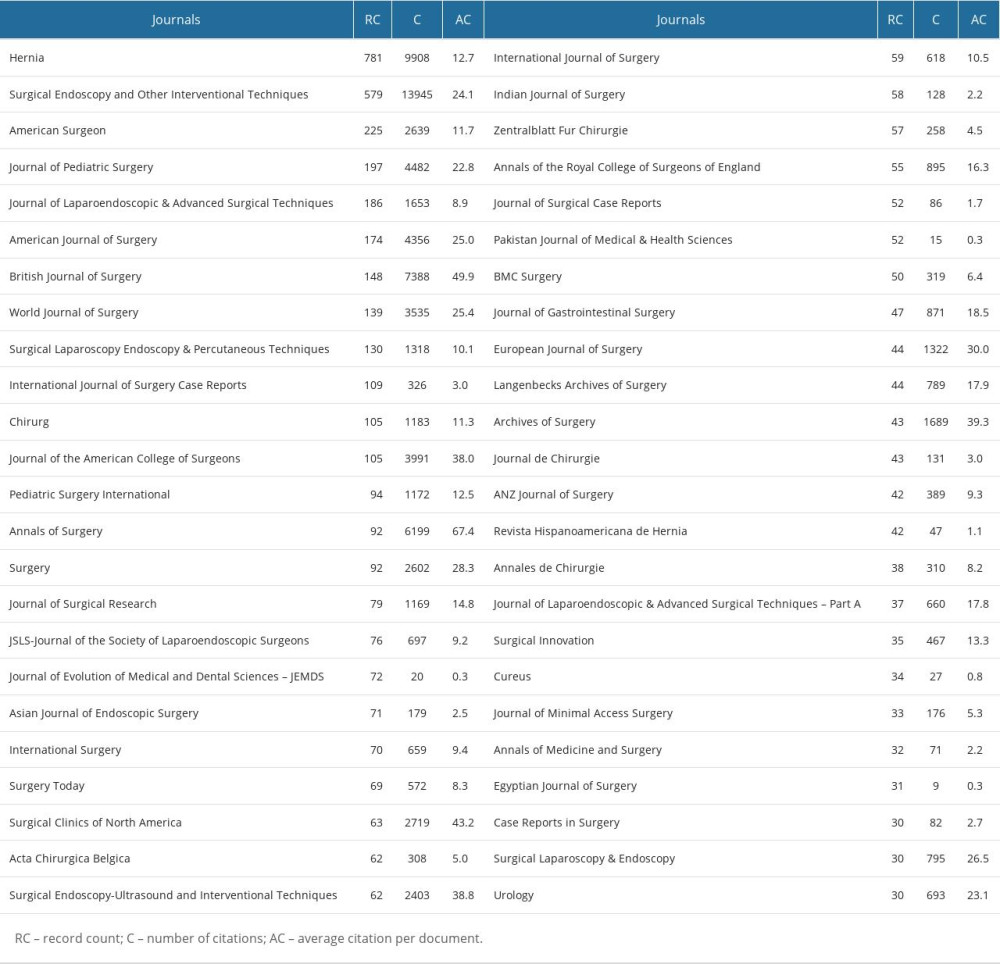 Table 1. The 48 most active journals that have published more than 30 articles on inguinal hernia.
Table 1. The 48 most active journals that have published more than 30 articles on inguinal hernia.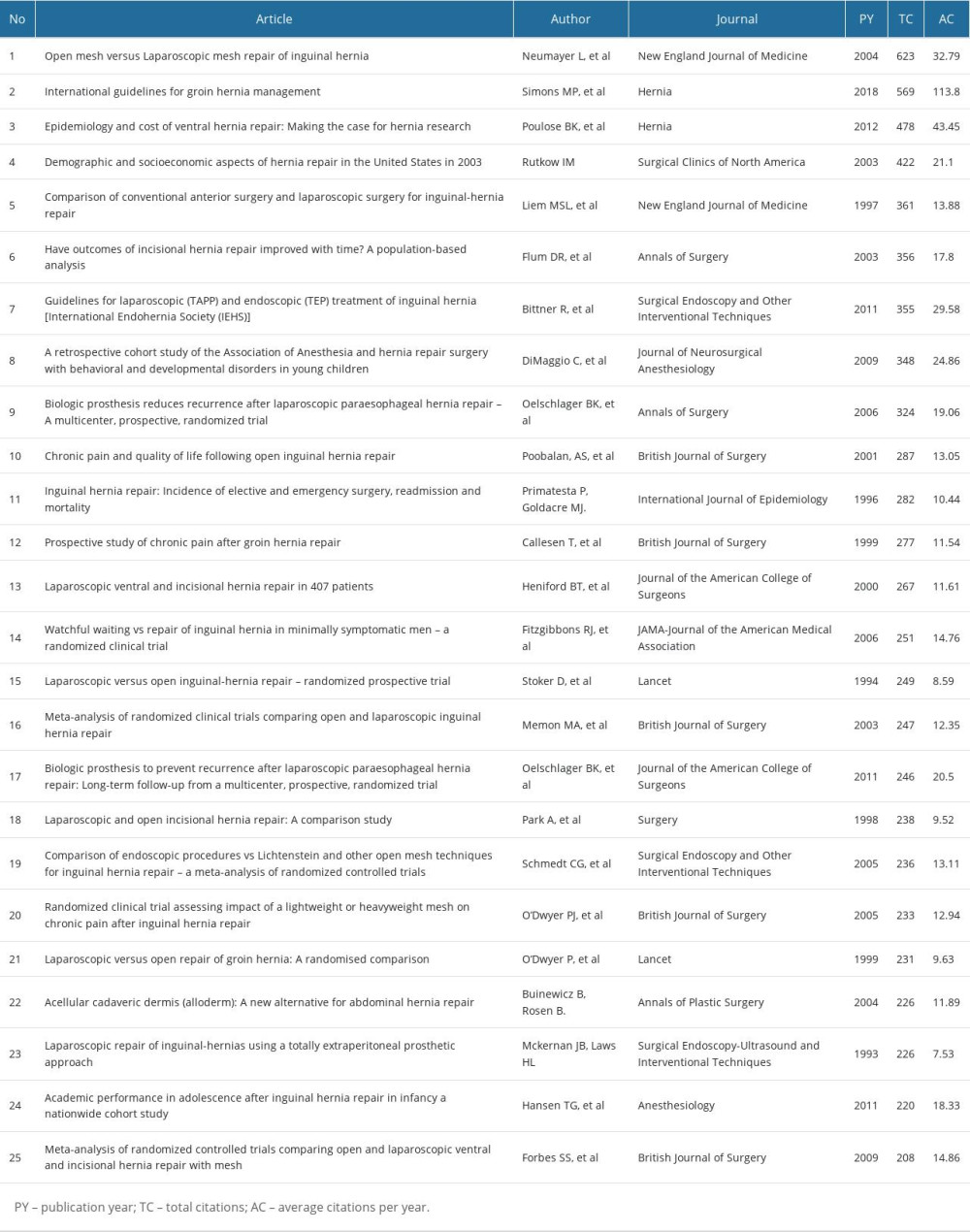 Table 2. The top 25 most cited articles on inguinal hernia by total number of citations.
Table 2. The top 25 most cited articles on inguinal hernia by total number of citations.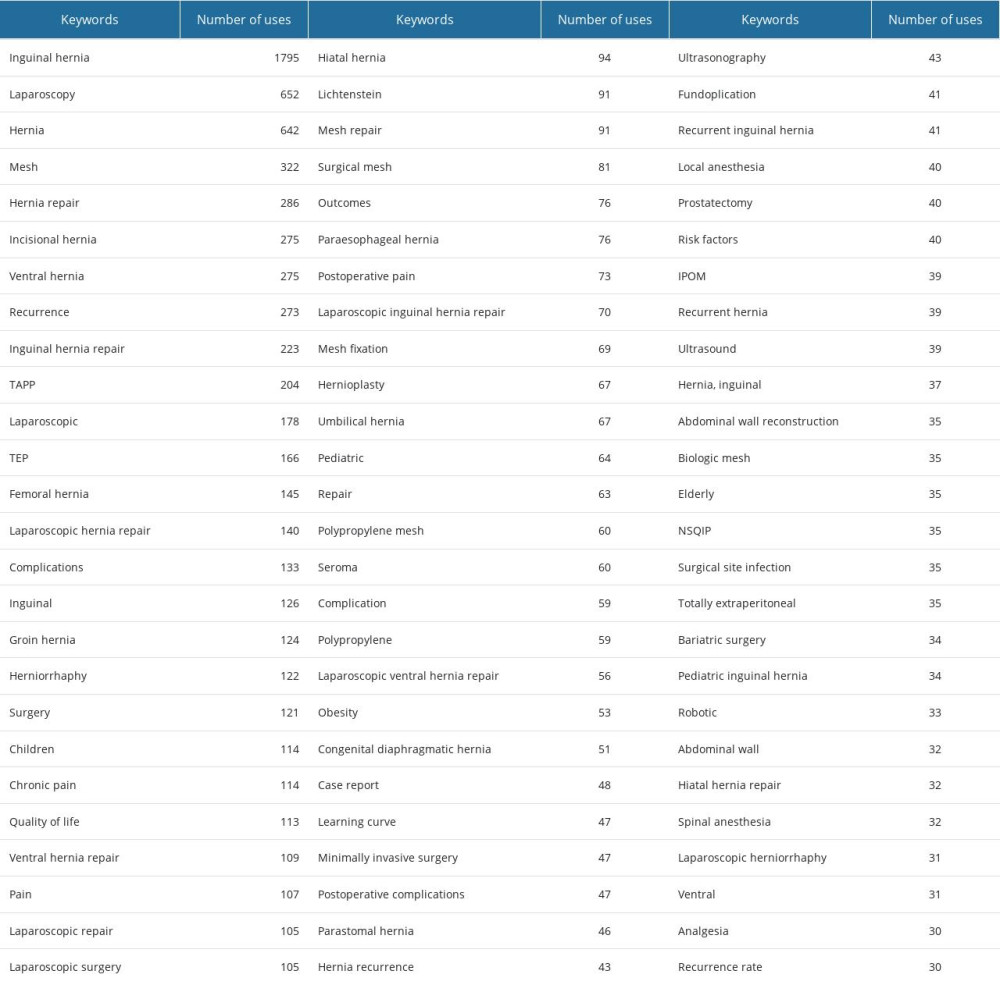 Table 3. The 78 most frequently used keywords in articles on inguinal hernia.
Table 3. The 78 most frequently used keywords in articles on inguinal hernia. Table 1. The 48 most active journals that have published more than 30 articles on inguinal hernia.
Table 1. The 48 most active journals that have published more than 30 articles on inguinal hernia. Table 2. The top 25 most cited articles on inguinal hernia by total number of citations.
Table 2. The top 25 most cited articles on inguinal hernia by total number of citations. Table 3. The 78 most frequently used keywords in articles on inguinal hernia.
Table 3. The 78 most frequently used keywords in articles on inguinal hernia. In Press
05 Mar 2024 : Clinical Research
Role of Critical Shoulder Angle in Degenerative Type Rotator Cuff Tears: A Turkish Cohort StudyMed Sci Monit In Press; DOI: 10.12659/MSM.943703
06 Mar 2024 : Clinical Research
Comparison of Outcomes between Single-Level and Double-Level Corpectomy in Thoracolumbar Reconstruction: A ...Med Sci Monit In Press; DOI: 10.12659/MSM.943797
21 Mar 2024 : Meta-Analysis
Economic Evaluation of COVID-19 Screening Tests and Surveillance Strategies in Low-Income, Middle-Income, a...Med Sci Monit In Press; DOI: 10.12659/MSM.943863
10 Apr 2024 : Clinical Research
Predicting Acute Cardiovascular Complications in COVID-19: Insights from a Specialized Cardiac Referral Dep...Med Sci Monit In Press; DOI: 10.12659/MSM.942612
Most Viewed Current Articles
17 Jan 2024 : Review article
Vaccination Guidelines for Pregnant Women: Addressing COVID-19 and the Omicron VariantDOI :10.12659/MSM.942799
Med Sci Monit 2024; 30:e942799
14 Dec 2022 : Clinical Research
Prevalence and Variability of Allergen-Specific Immunoglobulin E in Patients with Elevated Tryptase LevelsDOI :10.12659/MSM.937990
Med Sci Monit 2022; 28:e937990
16 May 2023 : Clinical Research
Electrophysiological Testing for an Auditory Processing Disorder and Reading Performance in 54 School Stude...DOI :10.12659/MSM.940387
Med Sci Monit 2023; 29:e940387
01 Jan 2022 : Editorial
Editorial: Current Status of Oral Antiviral Drug Treatments for SARS-CoV-2 Infection in Non-Hospitalized Pa...DOI :10.12659/MSM.935952
Med Sci Monit 2022; 28:e935952








